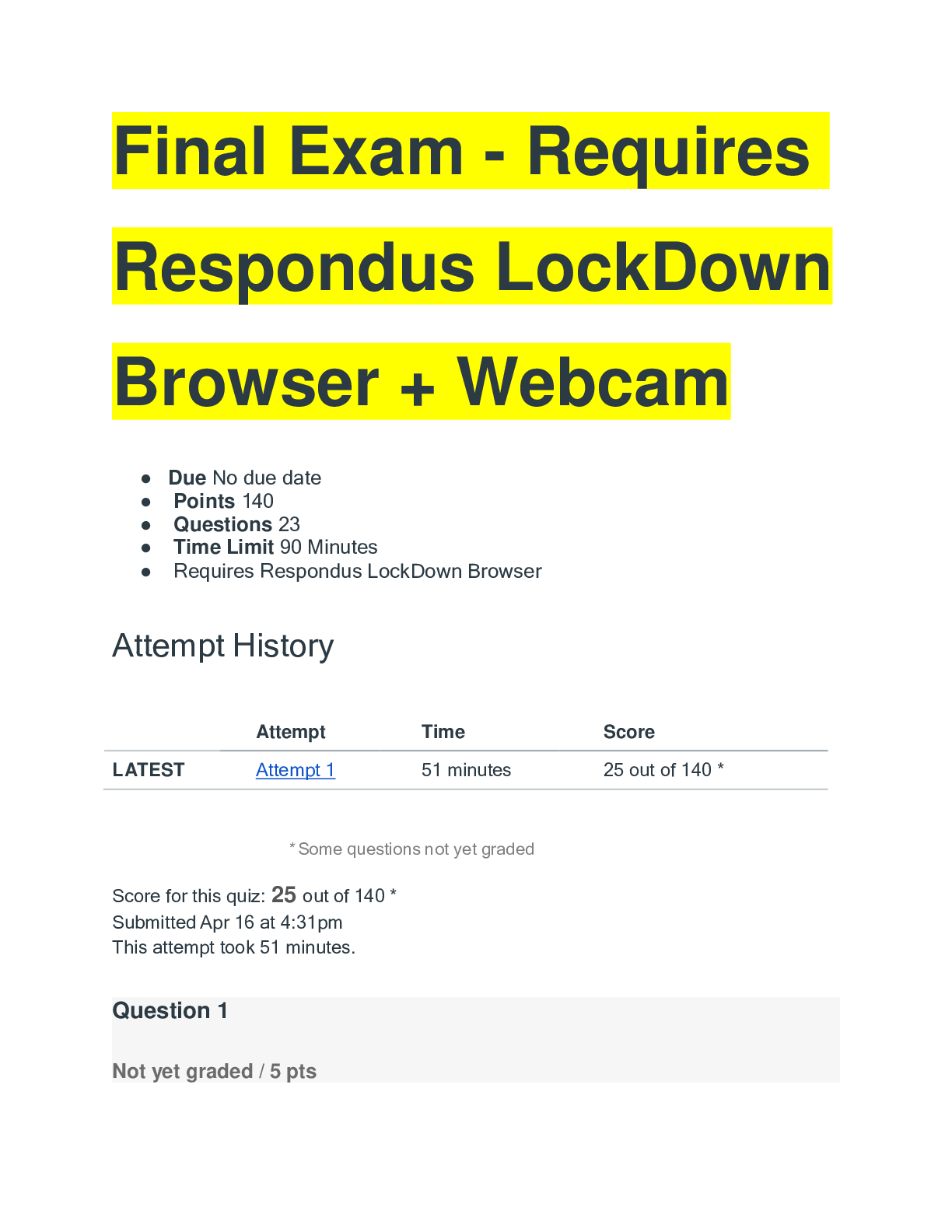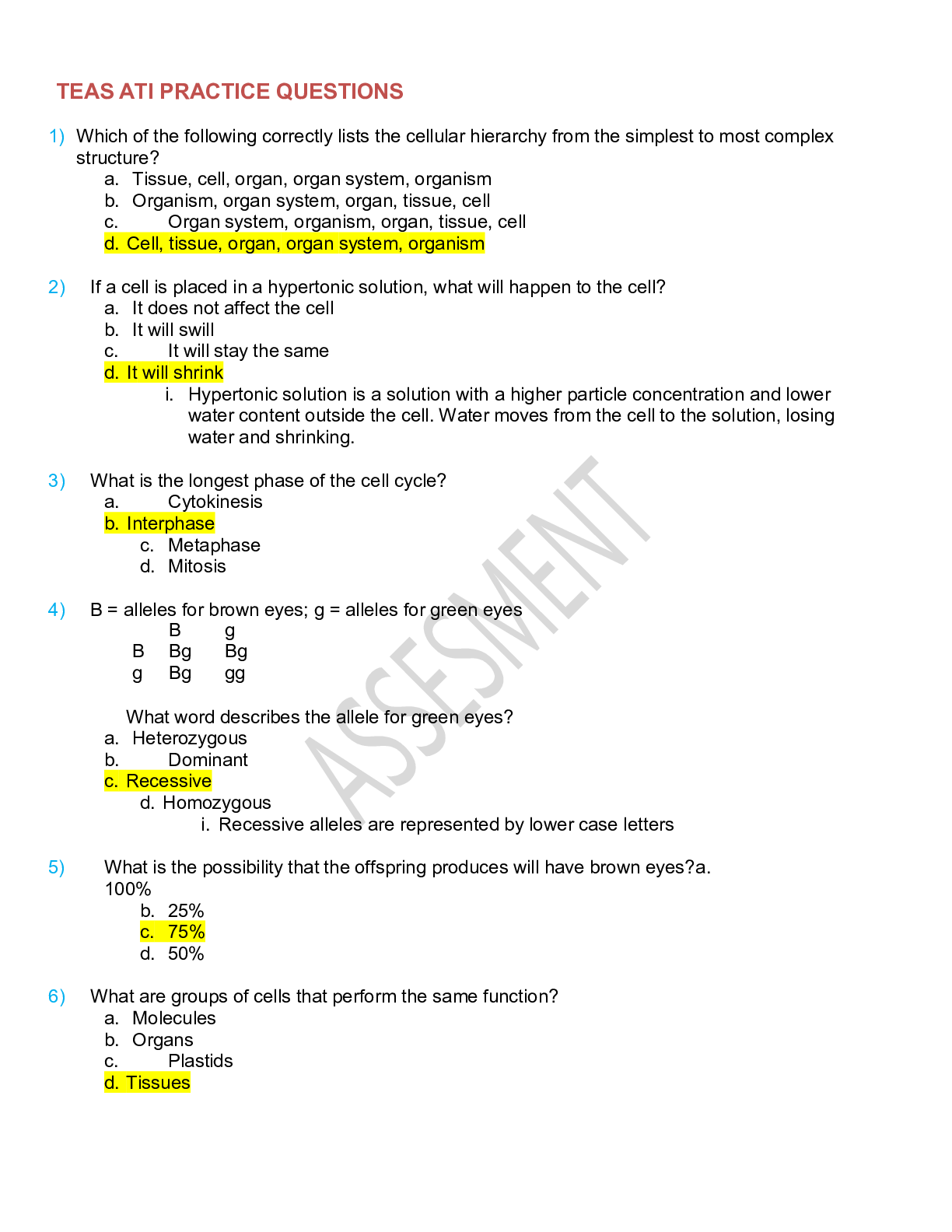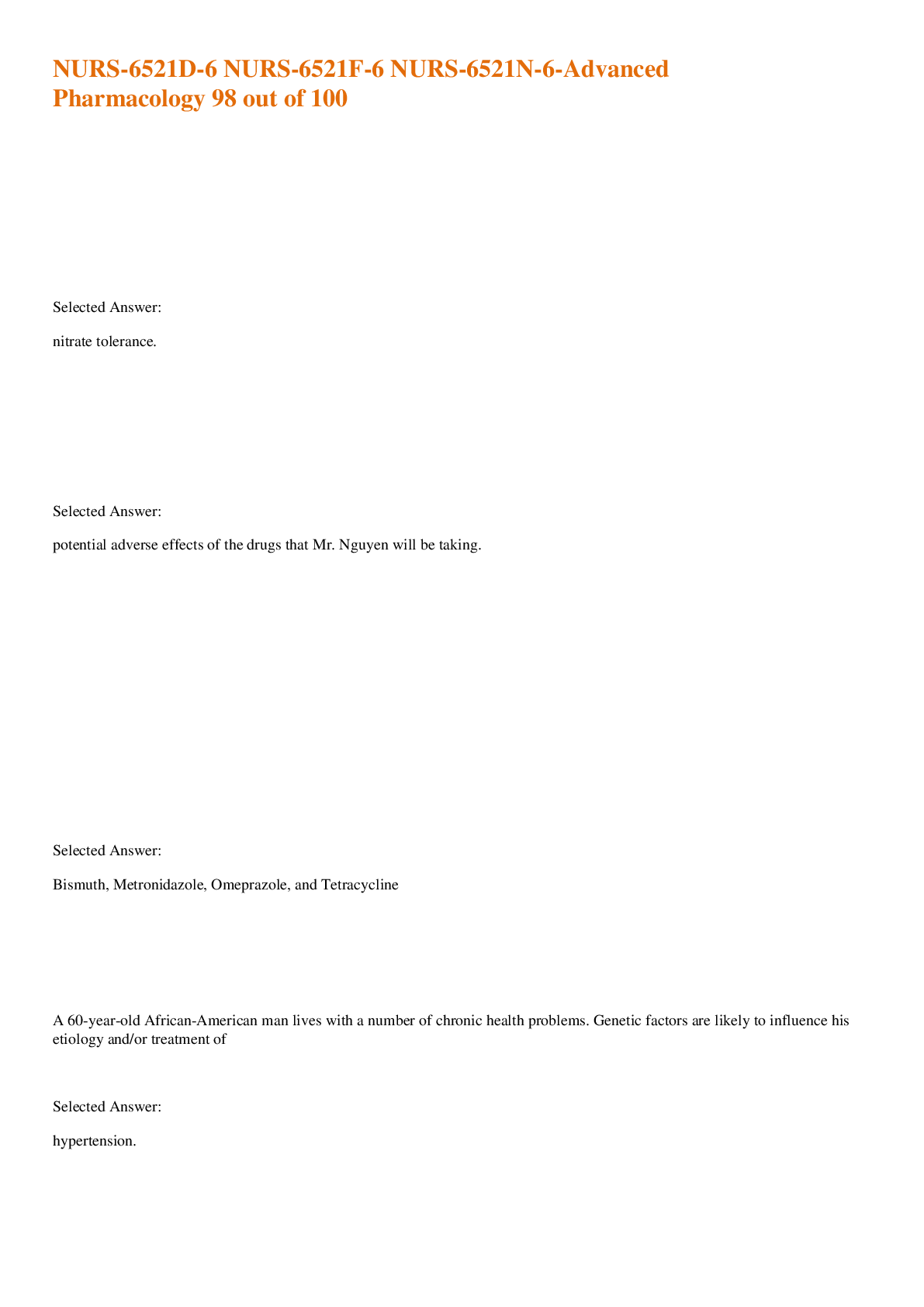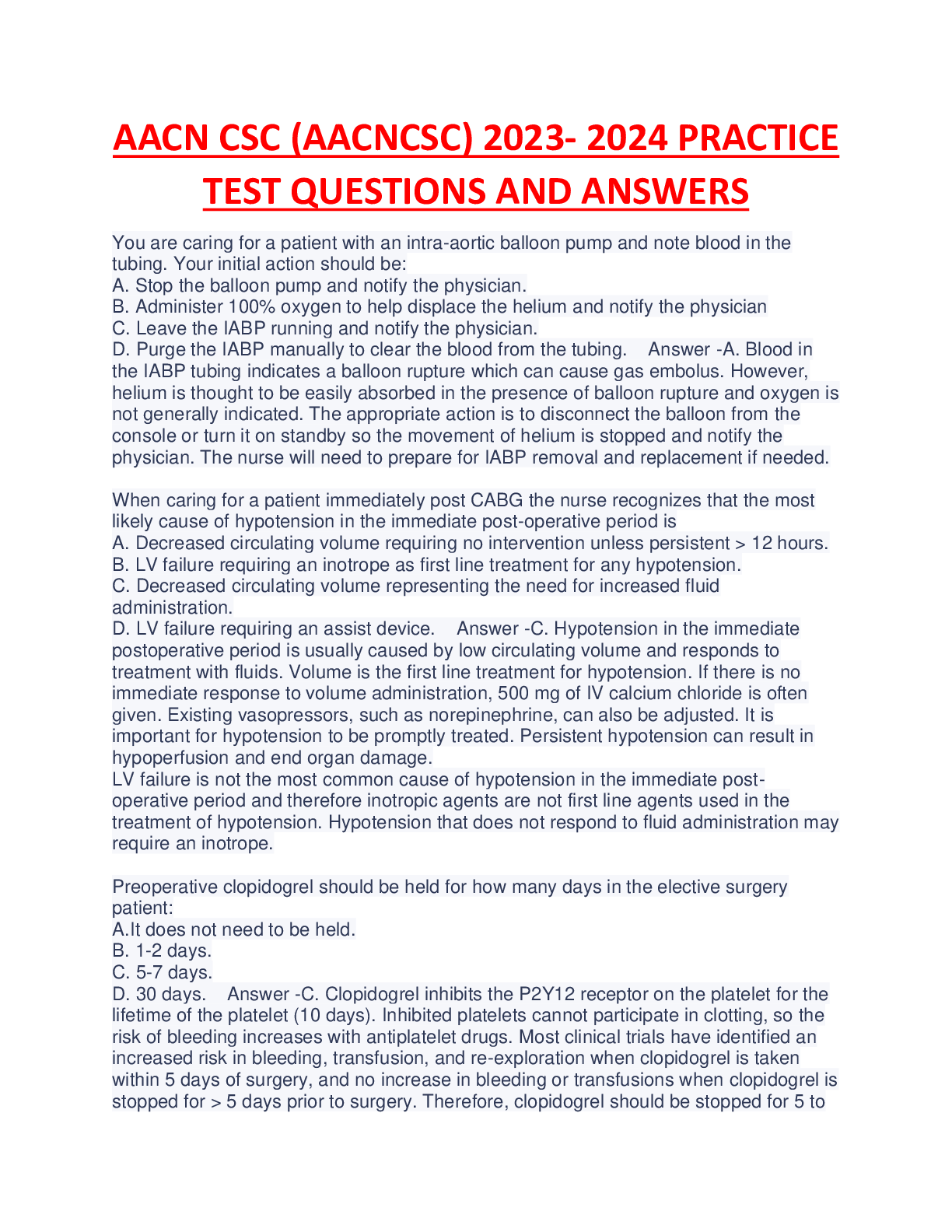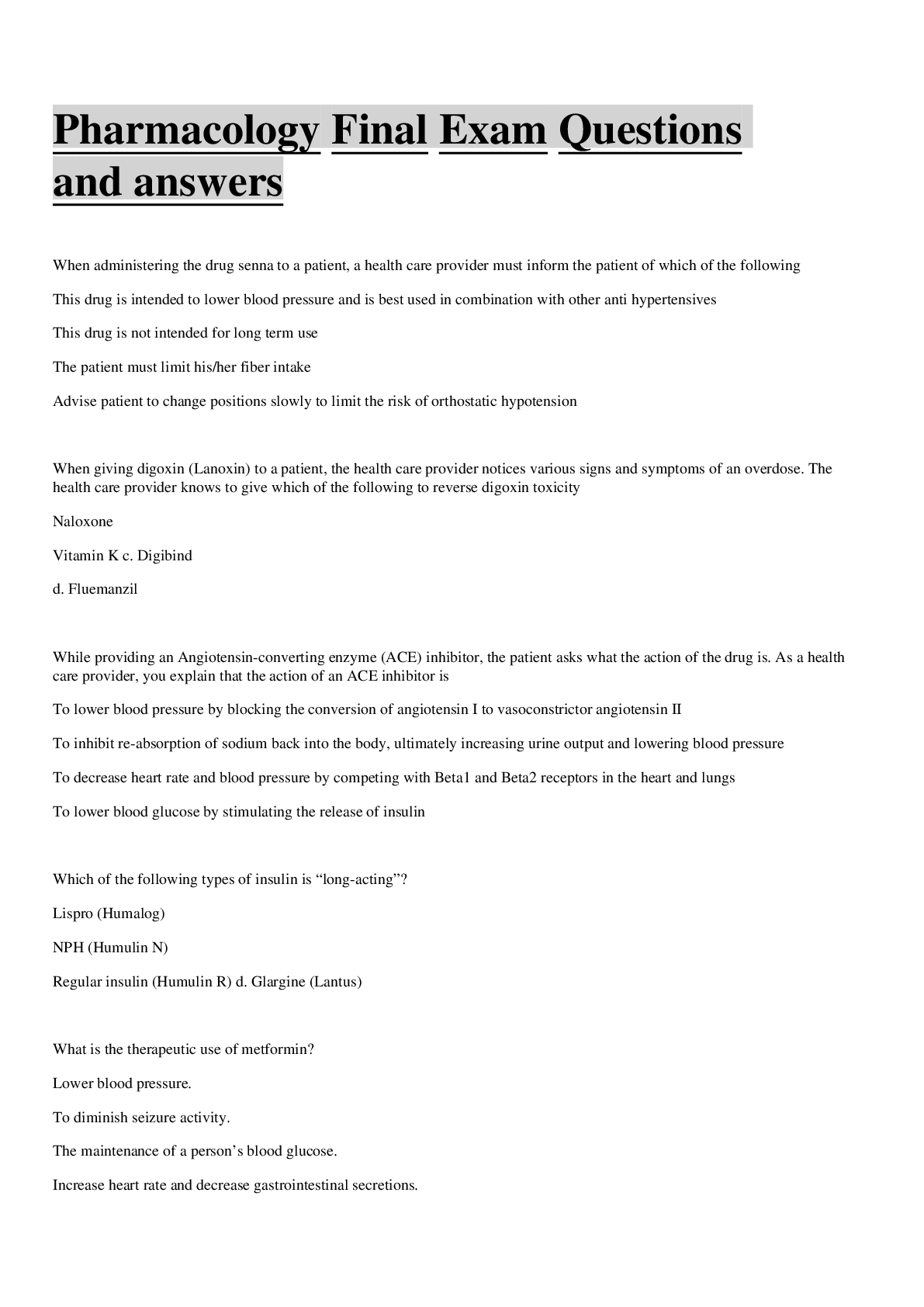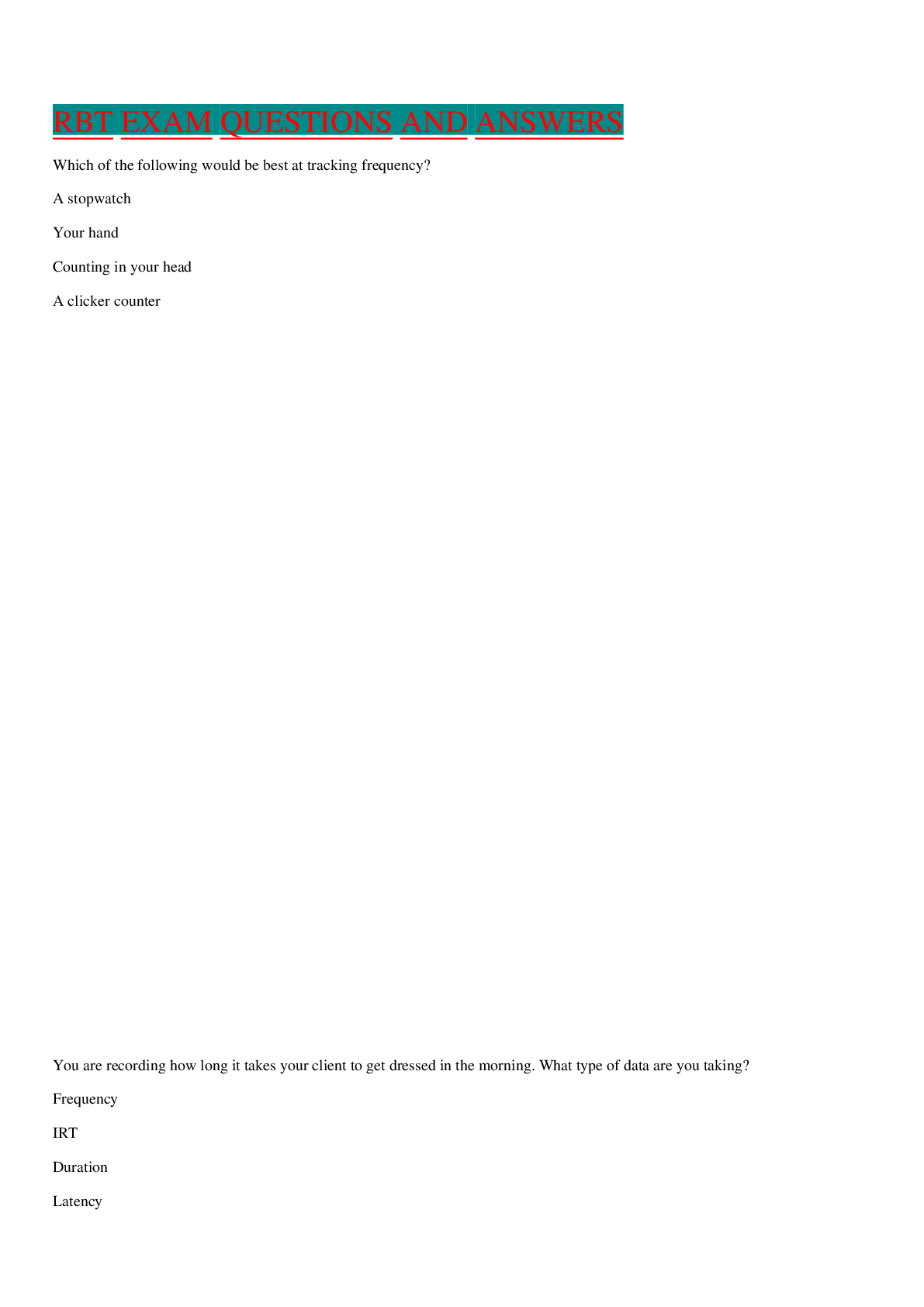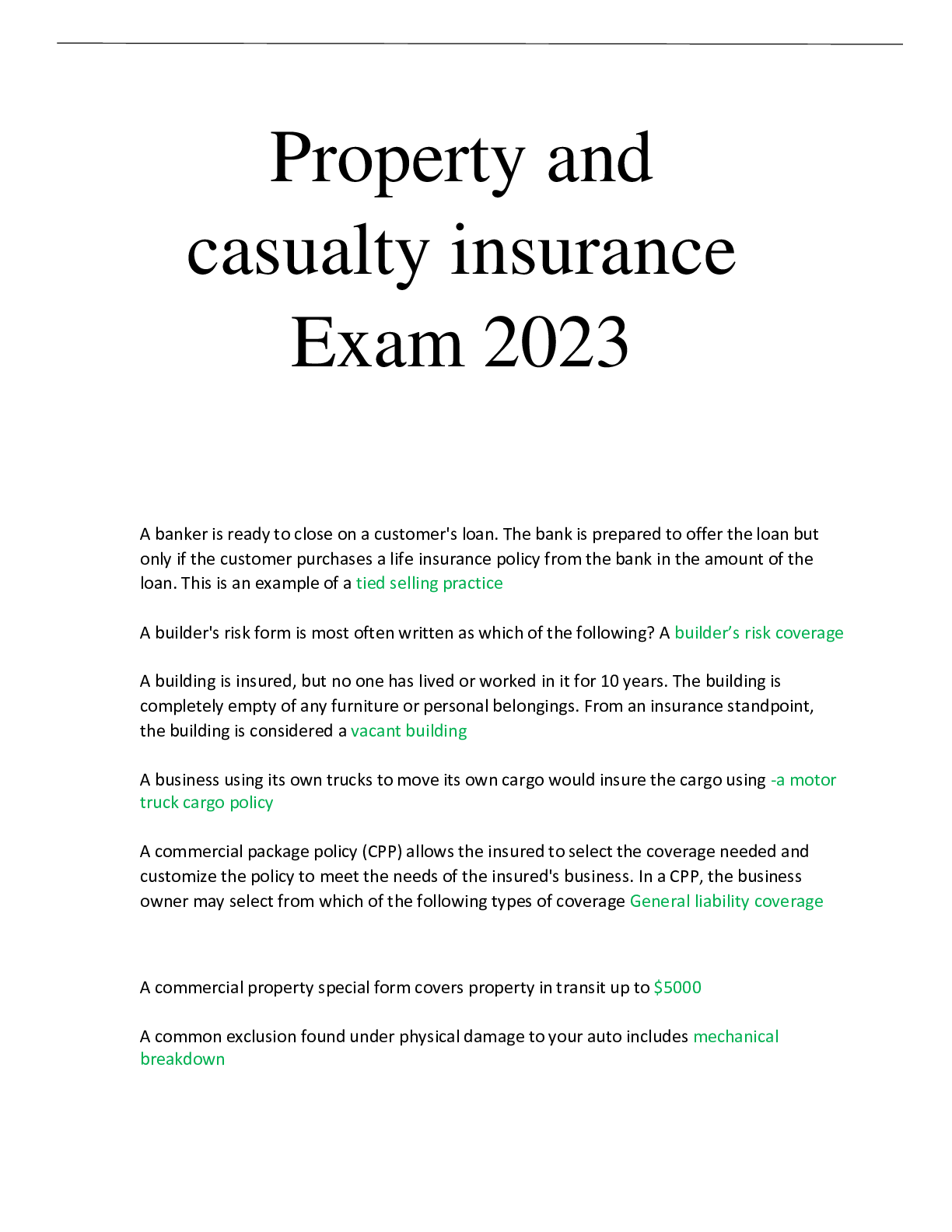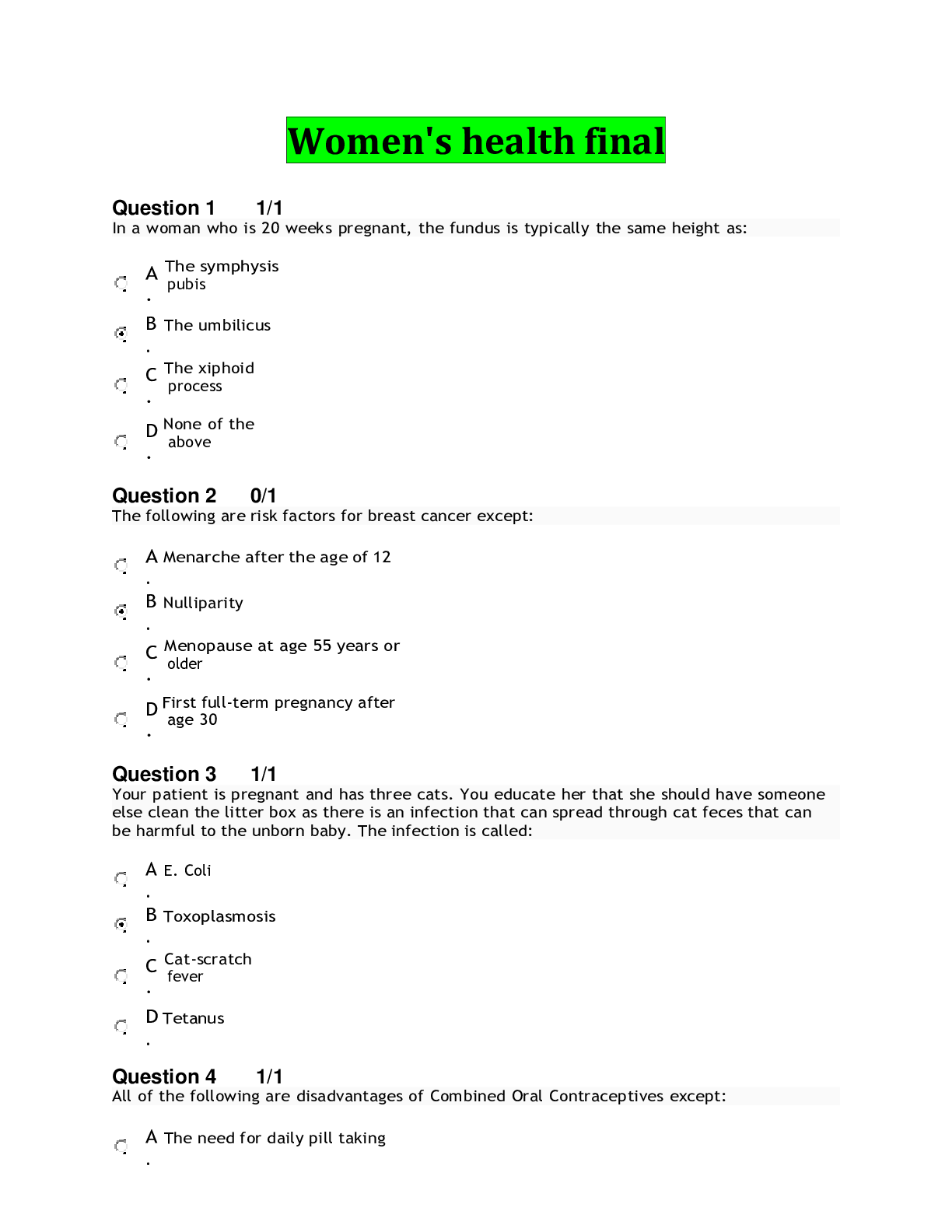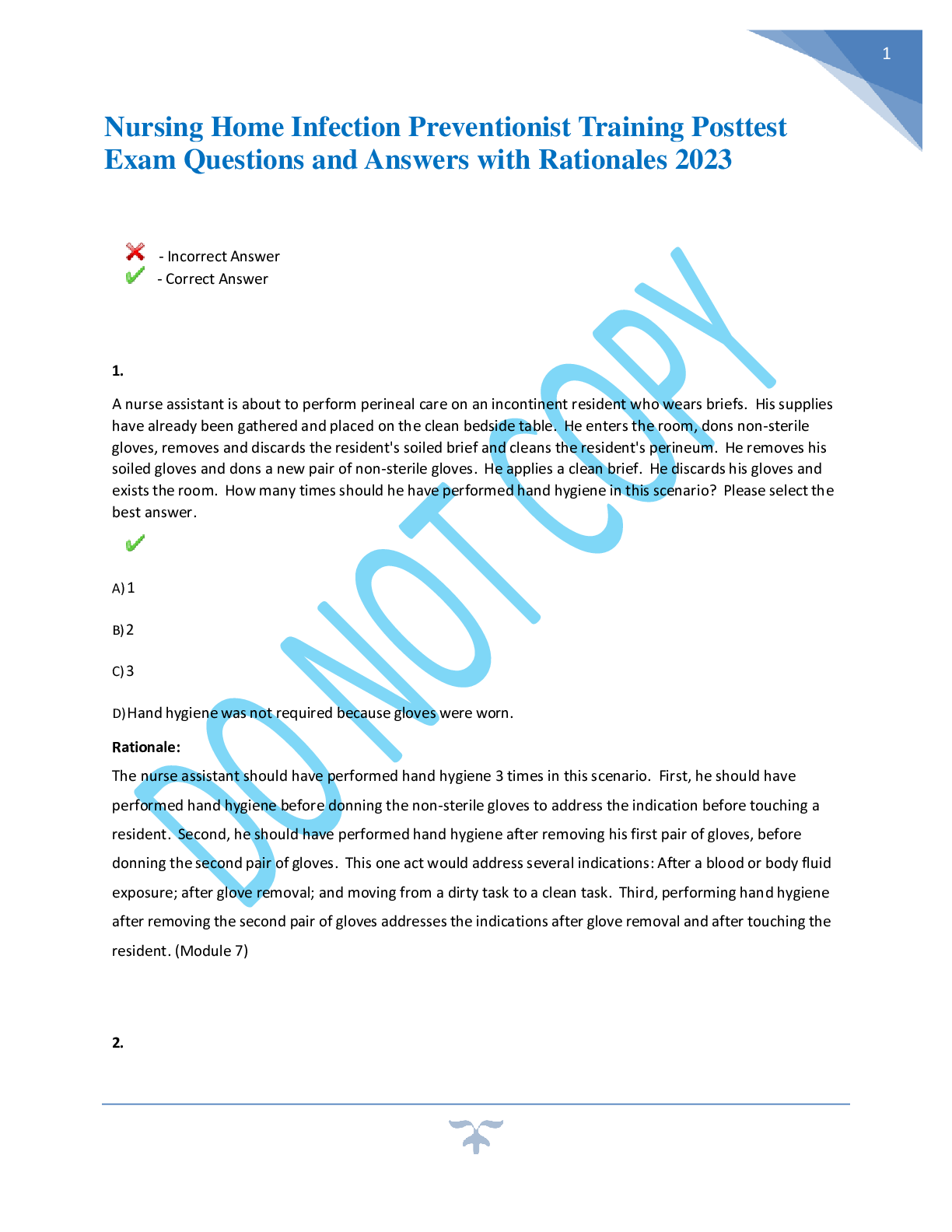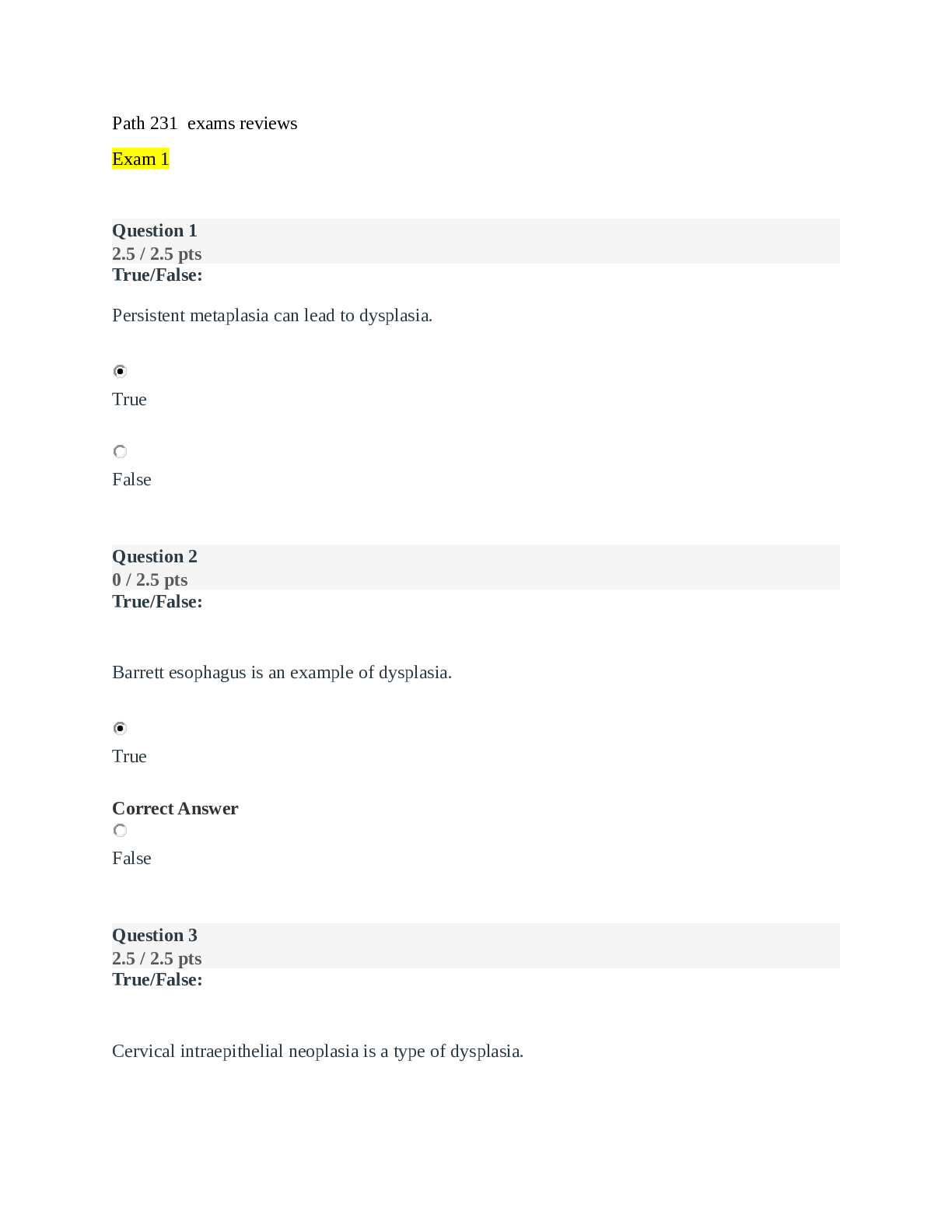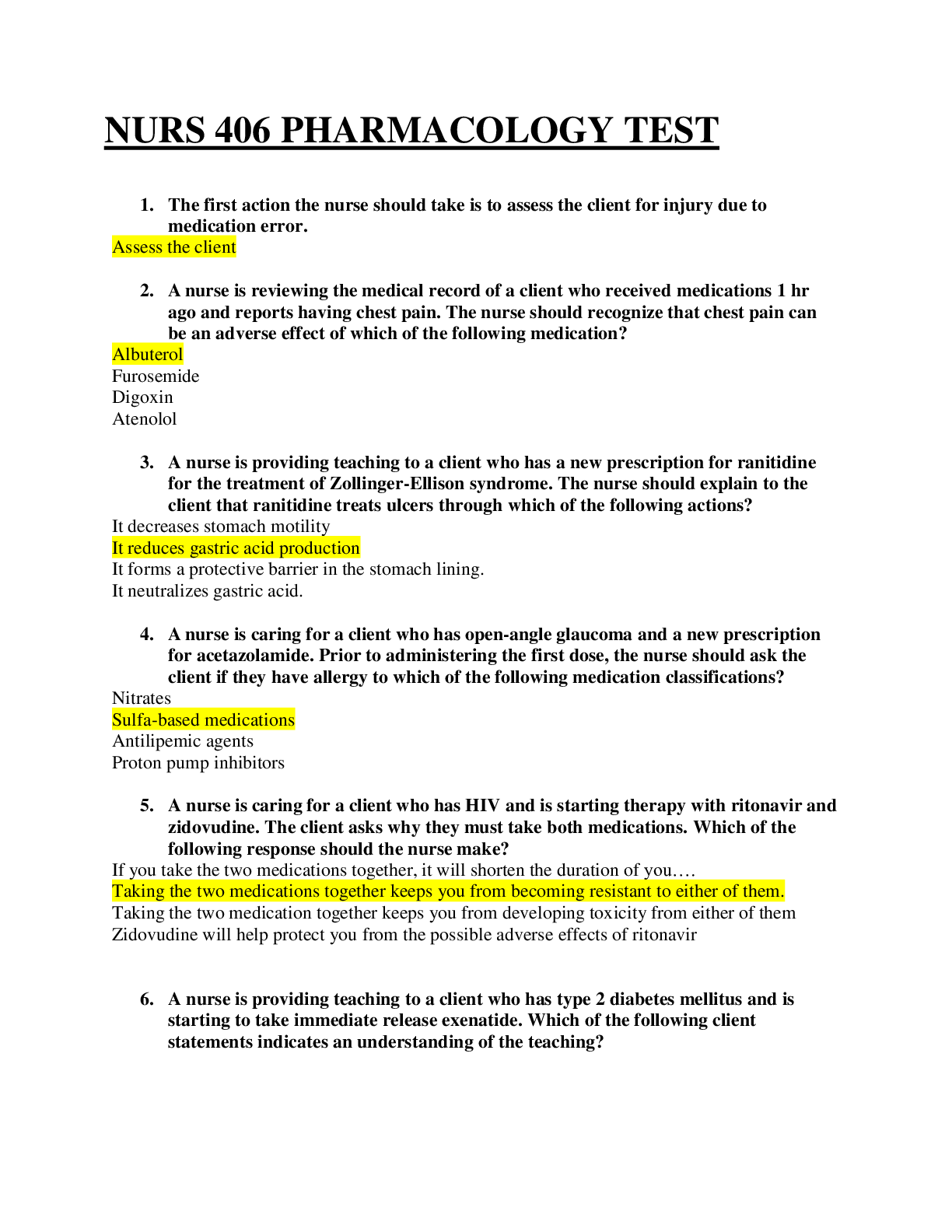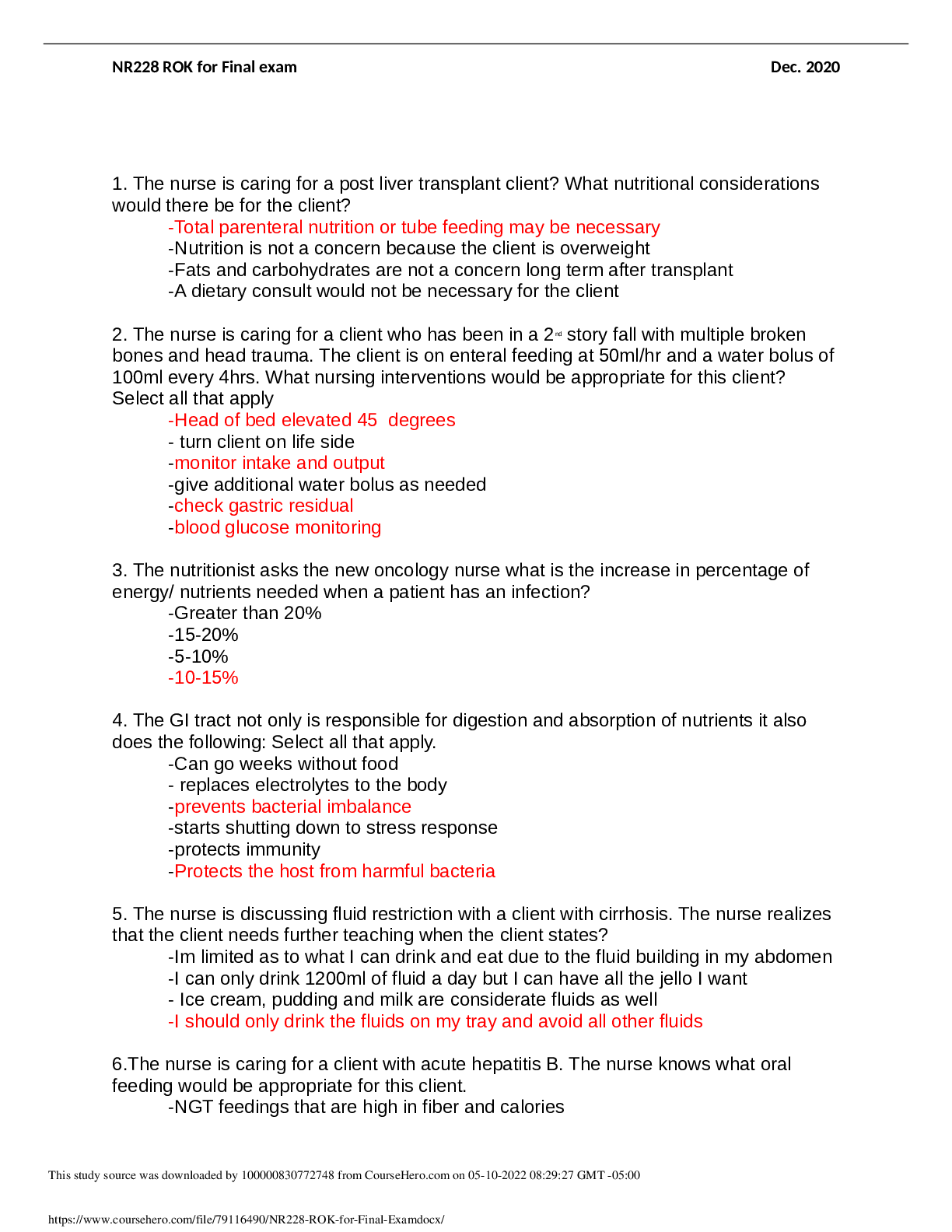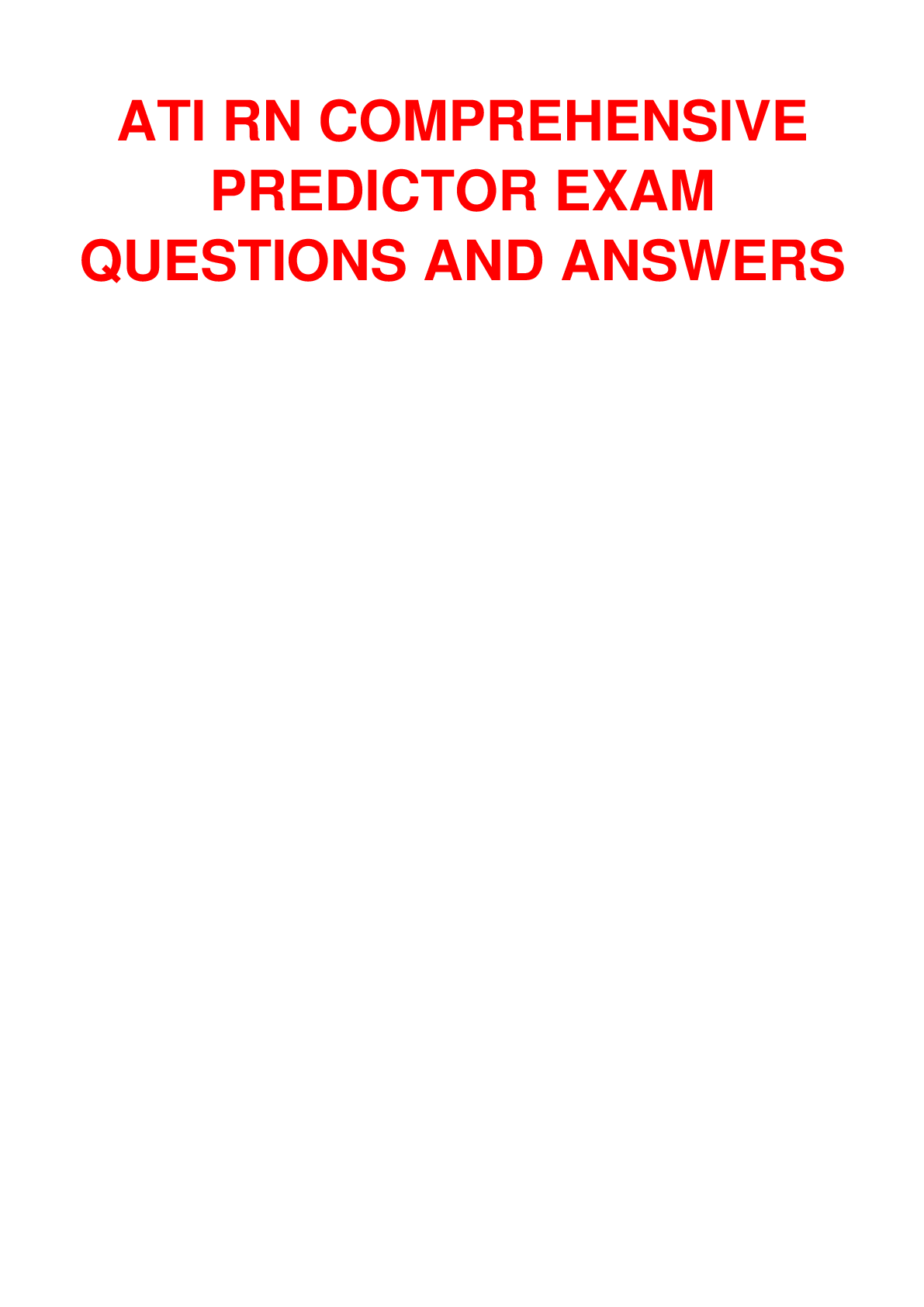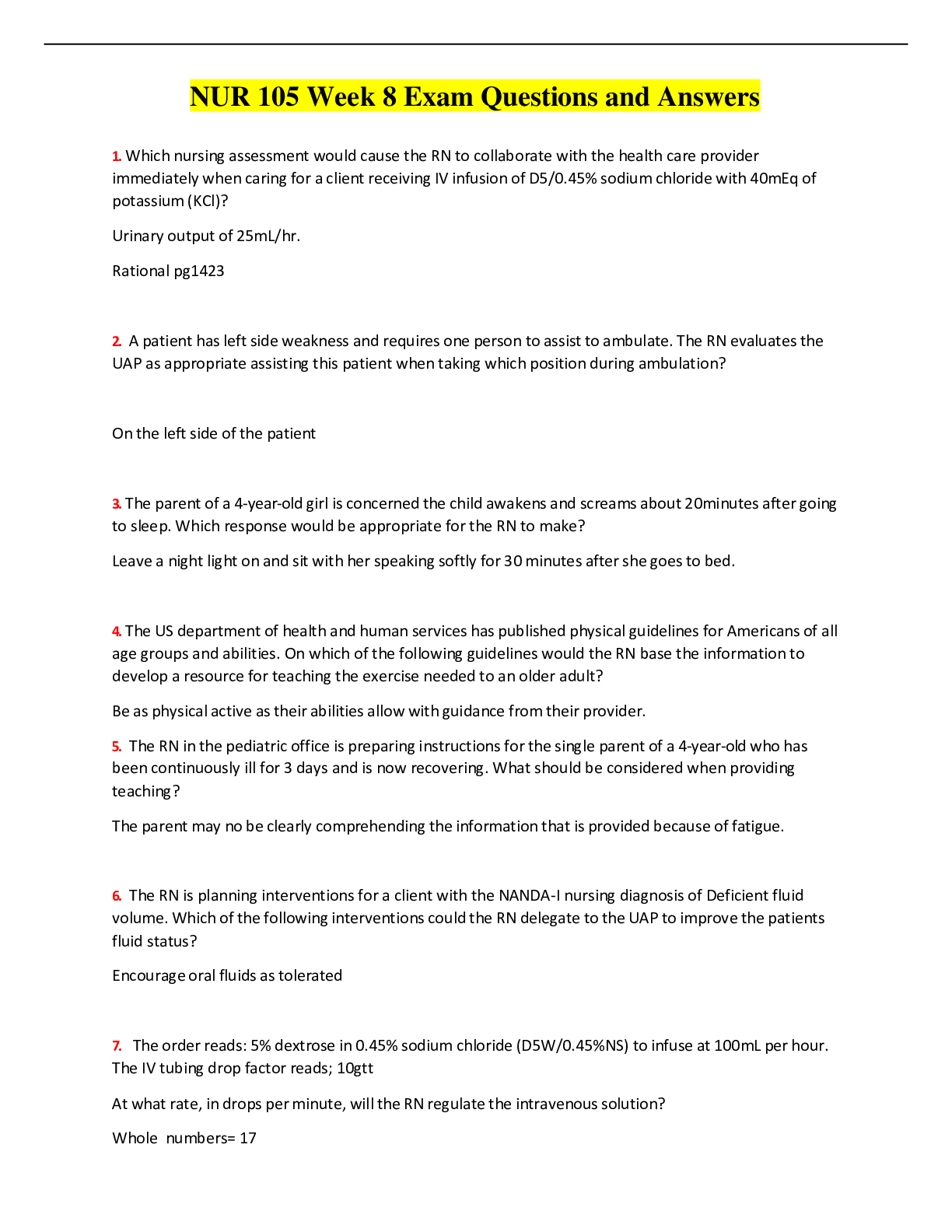NURS 6541 FINAL EXAM (Real Exam Questions and Answers)
Document Content and Description Below
Antibiotic therapy is one of the mainstays of treatment for which of the following causes of wheezing? Selected Answer: c. Epiglottitis • Question 3 1 out of 1 pointsDave, age 17, has gynecomas... tia. You should also assess him for Selected Answer: c. Testicular cancer • Question 4 1 out of 1 points A small-for-gestational-age infant is born to a 35-year-old woman. He has low-set and malformed ears, microcephaly, rocker-bottom feet, inguinal hernias, cleft lip/palate, and micrognathia. Chromosomal analysis is likely to reveal which of the following? Selected Answer: e. Edwards syndrome (trisomy 18) • Question 5 1 out of 1 points Primary dysmenorrhea is due to Selected Answer: a. Elevated prostaglandin level • Question 6 1 out of 1 points A 3-week-old male infant with 2 days of projectile, nonbilious vomiting and constant feeding. Which of the following is the most likely etiology?Selected Answer: f. Pyloric stenosis • Question 7 1 out of 1 points Which fo the following foods would be most appropriate for a child with celiac disease? Selected Answer: a. Rice with butter • Question 8 0 out of 1 points Which of the following is a measure of childhood intelligence? Selected Answer: a. Bayley scales • Question 9 1 out of 1 points An 8-month-old baby arrives to the office with his mother with a complaint of decreased left arm movement. He is a product of a normal term pregnancy, has had no medical problems, and was in good health when his mother dropped him off at the daycare center. Upper arm radiographs show a left humerus spiral fracture. Which of the following is the most appropriate next step in management? Selected b. Answer:Send the child to the hospital for admission and call child protective services. • Question 10 1 out of 1 points A 4-year-old female with profuse vomiting, sweating, lacrimation, and diarrhea, who seizes in the emergency room. Which of the following is the most likely etiology? Selected Answer: f. Insecticide ingestion • Question 11 1 out of 1 points A 9-year-old is diagnosed with dyspepsia without hematemesis, melena, or occult blood. The most appropriate next step is Selected Answer: d. Trial of ranitidine (Zantac) • Question 12 1 out of 1 points Which of the following therapeutic options is common for the treatment of both bee stings and bite wounds? Selected Answer: d.Tetanus vaccination • Question 13 1 out of 1 points You are examining Beth, age 9 months, and note a palpable right supraclavicular node. You know that this finding is suspicious for Selected Answer: d. Lymphoma of the mediastinum • Question 14 1 out of 1 points When examining a child with abdominal pain, what symptom would lead to a likely organic etiology? Selected Answer: c. Night waking • Question 15 1 out of 1 points Which of the following objective data are associated with significantly better long-term outcomes in children born with open spina bifida? Selected Answer: b. Perineal sensation• Question 16 1 out of 1 points A 14-year-old has a 3-week history of fever, anorexia, and abdominal pain. What additional symptom would cause the NP to suspect Crohn's disease? Selected Answer: b. Blood, mucous diarrhea • Question 17 1 out of 1 points A 3-year-old presents with macrocephaly, developmental delay, coarse facial features, large tounge, kyphosis, hip dislocation, tonsillar and adenoidal hypertrophy, and hepatomegaly. She is receiving early intervention services without improvement. What is the best next step? Selected Answer: a. Refer to genetics for further evaluations • Question 18 1 out of 1 points Ben has been diagnosed with folliculitis, an inflammatory condition involving the pilosebaceous follicle. What is the most common cause of this condition? Selected Answer: d. Staphylococcus aureus • Question 191 out of 1 points Which of the following is not true of insect stings from bees, wasps, and fire ants? Selected Answer: b. Greater reaction of hypersensitivity occurs most often with the initial exposure than with subsequent exposures. • Question 20 1 out of 1 points Unilateral wheezing is a finding suggestive of Selected Answer: c. Foreign body aspiration • Question 21 1 out of 1 points A 16-year-old is brought in as a walk-in by his parents. His parents state that he acutely developed a fever, chills and rash. He has been confused and not answering their questions. On examination he is toxically ill appearing, and is febrile, tachycardia and hypotensive. He is noted to have a diffuse petechial rash. What is the most likely diagnosis? Selected Answer: d. Meningococcemia • Question 22 1 out of 1 pointsA 12-year-old girl was brought to the emergency department because of severe sore throat, muffled voice, drooling, and fatigue. She had been sick for the past 3 days and is unable to eat because of painful swallowing. The parents deny any history of recurrent pharyngitis. The patient still managed to open her mouth and you were able to see an abscess at the upper pole of the right tonsil with deviation of the uvula toward the midline. Examination of the neck reveals enlarged and tender lymph nodes. Which of the following is the most appropriate management? Selected Answer: c. Incision and drainage of the abscess • Question 23 1 out of 1 points A 15-day-old infant has respiratory distress. A quick observation suggests she has slight cyanosis, hepatosplenomegaly, and features consistent with Down Syndrome. The cardiac examination demonstrates a loud first heart sound, a low-pitched, middiastolic murmur at the lower left sternal border, and a harsh apical holosystolic murmur in the mitral area. Which of the following cardiac conditions most likely explains her heart findings? Selected Answer: c. Complete atrioventricular canal (endocardial cushion defect) • Question 24 1 out of 1 points The organism that causes hand, foot, mouth syndrome is what virus? Selected Answer: d. Coxsackie• Question 25 1 out of 1 points Your patient has inflammatory bowel disease. Which of the following finding is most consistent with ulcerative colitis? Selected Answer: a. Left-sided abdominal pain • Question 26 1 out of 1 points Jesse, age 5, has a diagnosis of encopresis. After the diagnosis, what would be your next action? Selected Answer: b. Rule out a neurologic disorder. • Question 27 1 out of 1 points The parents of an 8-year-old Down Syndrome boy arrive for his annual well-child visit. He wants to participate in sports, including the Special Olympics. Until further examination can be completed, which of the following sports would you suggest as being safe? Selected Answer: e. Tennis • Question 28 1 out of 1 pointsSix months after being diagnosed with what appears to be insulin-dependent diabetes, the 5- year-old in the case presentation has a significant decrease in his insulin requirement. Which of the following is the most likely explanation? Selected Answer: a. He has entered the "honeymoon phase" of his diabetes. • Question 29 1 out of 1 points The classic radiographic finding of croup is Selected Answer: d. Steeple sign • Question 30 1 out of 1 points A common cause of in-toeing in childhood is Selected Answer: a. Internal tibial torsion • Question 31 1 out of 1 points Mrs. Bay is upset. She is convinced something is seriously wrong with her son. He is a 2- month-old and frequently vomits after feeding. Which of the following is most suggestive of GERD (gastroesophageal reflux disease)?Selected Answer: d. He drinks 7 to 8 ounces every 3 hours. • Question 32 0 out of 1 points Which of the following is true regarding the diagnosis of epiglottitis? Selected Answer: a. Every effort should be made to visualize the epiglottitis in the office and confirm the diagnosis • Question 33 1 out of 1 points Of the following patients, which child should not receive a tuberculin skin test? Selected Answer: d. A 2-year-old who was infected with RSV 2 months ago and is currently asymptomatic. • Question 34 1 out of 1 points Hope is a 7-month-old who presents in January with a 1-day history of cough, yellow nasal discharge, and low-grade temp (T max 100°F). She was previously healthy. She does have 2+ edema of the nasal turbinates and cloudy rhinorrhea. She is afebrile in the office. Her chest, mouth, and ears are clear. You prescribe: Selected Answer: b.Saline drops, bulb suction, humidified air, and increased PO fluids • Question 35 1 out of 1 points An ex-preemie with bronchopulmonary dysplasia has been discharged to home from the NICU. One potential problem area that requires close monitoring is Selected Answer: d. Insufficient caloric intake. • Question 36 1 out of 1 points Which of the following symptoms are most suggestive of pneumonia in a young child? Selected Answer: a. Fever, tachypnea, coryza, cough, scattered rales • Question 37 1 out of 1 points A 14-month-old child has lower extremity bowing, a waddling gait, genu varum, and is at the 5th percentile for height. Laboratory data include low-normal serum calcium, moderately low serum phosphate, and elevated serum alkaline phosphatase levels, hyperphosphaturia, and normal parathyroid levels. Which of the following is the most likely diagnosis? Selected Answer: c.Genetic primary hypophosphatemia • Question 38 0 out of 1 points Lisa has Cushing's syndrome. You would suspect her to have or to develop Selected Answer: b. Generalized increased pigmentations of the skin • Question 39 1 out of 1 points You have a patient that you think may have intussusception. Which of the following finding may you see? Selected Answer: b. Inconsolable screaming • Question 40 1 out of 1 points An 11-month-old male with intermittent bouts of crying and nonbilious vomiting, has a history of Meckel diverticulum. A small elongated mass is felt on the right side of his abdomen. Which of the following is the most likely etiology? Selected Answer: e. Intussusception• Question 41 1 out of 1 points Tracy, the mother of a 2-year-old, is concerned because her daughter walks on her toes all the time. What do you tell her? Selected Answer: d. Toe walking is considered normal until age 3. • Question 42 1 out of 1 points Mark, age 15, is 5 feet tall andn weighs 85 pounds. You suspect anorexia and know that the best initial approach is to Selected Answer: b. Confront Mark with the fact that you suspect an eating disorder. • Question 43 1 out of 1 points The following clinical description best matches which genetic disorder? A tall, thin 14- year-old boy has no signs of puberty. He was delayed in his speech development and always has done less well in school than his siblings. He is shy, and teachers report his activity is immature. Physical examination reveals breast development, and long limbs with a decreased upper segment/lower segment ration. He has small testes and phallus. Selected Answer: c. Klinefelter syndrome (XXY)• Question 44 1 out of 1 points Which test is routinely recommended for a preparticipation sports physical? Selected Answer: d. A Snellen test • Question 45 1 out of 1 points Prophylactic penicillin should be started in children with sickle cell anemia by Selected Answer: d. 2 to 3 months of age • Question 46 1 out of 1 points Which of the following statements is not true with slipped capital femoral epiphysis? Selected Answer: b. It is thought to be caused by repetitive stresses in young athletes prior to growth spurts. • Question 47 1 out of 1 points [Show More]
Last updated: 1 year ago
Preview 1 out of 34 pages

Reviews( 0 )
Document information
Connected school, study & course
About the document
Uploaded On
Apr 13, 2022
Number of pages
34
Written in
Additional information
This document has been written for:
Uploaded
Apr 13, 2022
Downloads
0
Views
137


